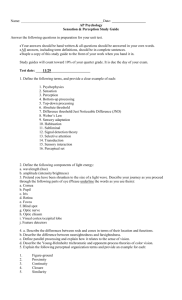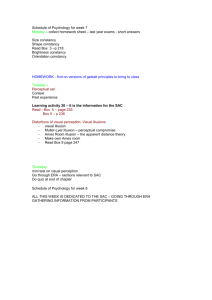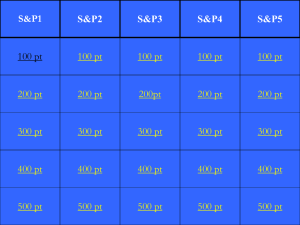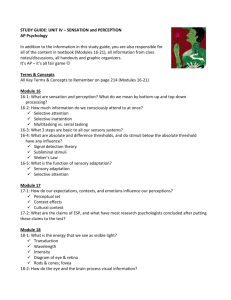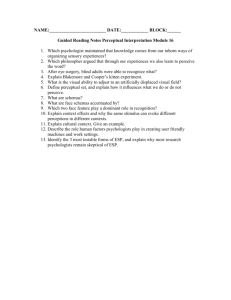Step Up To: Psychology
advertisement
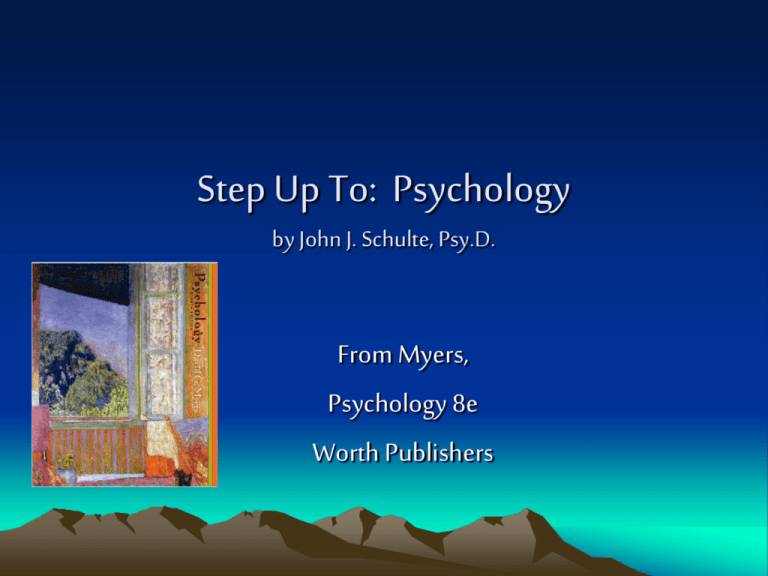
Step Up To: Psychology by John J. Schulte, Psy.D. From Myers, Psychology 8e Worth Publishers Chapter 6: Perception That looks funny! Get Organized! What’s it mean? Pay Attention! This and That Pay Attention! 500 400 300 200 100 Get Organized 500 400 300 200 100 That Looks Funny! 500 400 300 200 100 What’s it mean? 500 400 300 200 100 This and That 500 400 300 200 100 1. Our inability to consciously perceive all the sensory information available to us at any single point in time best illustrates the necessity of: • • • • A) perceptual constancy. B) selective attention. C) perceptual adaptation. D) retinal disparity. 2. While a student provided directions to a construction worker, two experimenters rudely interrupted by passing between them carrying a door. The student’s failure to notice the worker was replaced by a different person illustrates: • • • • A) retinal disparity. B) visual capture. C) change blindness. D) perceptual adaptation. 3. When the soundtrack for a movie is played in the back of a classroom, students tend to perceive the sound as originating from the picture screen in front of the room. This best illustrates: • • • • A) visual capture. B) location constancy. C) the phi phenomenon. D) perceptual adaptation. 4. Participants in an experiment were told to listen to and repeat a prose passage played in one ear, while a novel tune was played in their other ear. The results of this experiment indicated that they: • A) suffered a sense of discomfort. • B) were able to identify exactly which tune had been played. • C) produced an increasing level of alpha waves while exposed to music. • D) showed in increase in their liking for the novel tune. 5. Because she was listening to the news on the radio, Mrs. Schulte didn’t perceive a word of what her husband was saying. Her experience best illustrates: • • • • A) perceptual adaptation. B) the cocktail party effect. C) perceptual constancy. D) the phi phenomenon. 6. The Müller-Lyer illusion involves the misperception of: • • • • A) figure-ground relationships. B) relative clarity. C) binocular distance cues. D) the length of lines. 7. When there is a conflict between bits of information received by two or more senses, which sense tends to dominate the others in humans? • • • • A) hearing. B) vision. C) smell. D) none, they all work together equally. 8. When asked to estimate the distances of white disks under clear or foggy conditions, people: • A) judged them to be closer when viewed in the fog than in the sunshine. • B) found it impossible to make any distance estimates under foggy conditions. • C) judged the disks to be the same distance away whether viewed under clear or foggy conditions. • D) judged the disks to be farther away when viewed in the fog than when viewed in the sunshine. 9. The tendency to hear the steady drip of a leaky faucet as if it were a repeating rhythm of two or more beats best illustrates: • • • • A) perceptual constancy. B) the phi phenomenon. C) perceptual organization. D) perceptual adaptation. 10. When listening to rock music played backward, people often perceive an evil message only if specifically forewarned what to listen for. This best illustrates the dangers of: • • • • A) bottom-up processing. B) feature detection. C) perceptual set. D) the phi phenomenon. 11. The greatest difficulty facing contemporary parapsychology is the: • A) inability to subject claims of ESP to scientific testing. • B) lack of a reproducible ESP phenomenon. • C) willingness of most parapsychologists to knowingly accept fraudulent evidence. • D) difficulty of persuading many people that there really is such a thing as ESP. 12. Although college textbooks frequently cast a trapezoidal image on the retina, students typically perceive the books as rectangular objects. This illustrates the importance of: • • • • A) interposition. B) size constancy. C) linear perspective. D) shape constancy. 13. Which of the following cues do artists use to convey depth on a flat canvas? • • • • A) convergence. B) interposition. C) continuity. D) closure. 14. When the moon is near the horizon, it appears larger than when it is high in the sky. This effect is primarily a result of: • A) the slightly dimmer appearance of the horizon moon. • B) the scattering of the horizon moon’s light waves, which penetrate the atmosphere at an angle. • C) distance cues, which make the horizon moon seem farther away. • D) the brighter appearance of the horizon moon. 15. It has been suggested that experience with the corners of buildings and the rectangular shapes of a carpentered world may contribute to: • • • • A) the Ponzo illusion. B) shape constancy. C) the moon illusion. D) the Müller-Lyer illusion. 16. As the retinal image of a horse galloping toward you becomes larger, it is unlikely that the horse will appear to grow larger. This best illustrates the phenomenon of: • • • • A) visual capture. B) size constancy. C) closure. D) convergence. 17. Retinal disparity refers to the: • A) tendency to see parallel lines as coming together in the distance. • B) tendency to see stimuli that are near each other as parts of a unified object. • C) somewhat different images our two eyes receive of the same object. • D) extent to which our eyes turn toward each other when looking at an object. 18. The perceptual tendency to fill in gaps in order to perceive disconnected parts as a whole object is called: • • • • A) closure. B) constancy. C) interposition. D) convergence. 19. The perception of the letter “t” as two intersecting lines rather than as four nonintersecting lines illustrates the principle of: • • • • A) convergence. B) proximity. C) closure. D) continuity. 20. The organizational principles identified by Gestalt psychologists best illustrate the importance of: • • • • A) perceptual constancy. B) retinal disparity. C) top-down processing. D) perceptual adaptation. 21. Gestalt psychologists emphasize that: • A) perception is the same as sensation. • B) the whole is more than the sum of its parts. • C) we learn to perceive the world through experience. • D) sensation has no effect on perception. 22. The perception of an object as distinct from its surroundings is called: • • • • A) perceptual set. B) perceptual constancy. C) figure-ground perception. D) the phi-phenomenon. 23. Human factors psychologists would be most likely to aid in the design of: • • • • A) computer keyboards. B) weight-reduction programs. C) protective clothing. D) classroom management techniques. 24. The illusion of movement in animated neon signs is known as: • • • • A) interposition. B) relative motion. C) retinal disparity. D) the phi phenomenon. 25. As she gazed down from a bridge at the rapidly flowing river, Nancy felt as thought she were moving. Her experience best illustrates the phenomenon of: • • • • A) retinal disparity. B) perceptual adaptation. C) location constancy. D) visual capture. Stop here, or continue as a review 1. Our inability to consciously perceive all the sensory information available to us at any single point in time best illustrates the necessity of: • • • • A) perceptual constancy. B) selective attention. C) perceptual adaptation. D) retinal disparity. 237 2. While a student provided directions to a construction worker, two experimenters rudely interrupted by passing between them carrying a door. The student’s failure to notice the worker was replaced by a different person illustrates: • • • • A) retinal disparity. B) visual capture. C) change blindness. D) perceptual adaptation. 239 3. When the soundtrack for a movie is played in the back of a classroom, students tend to perceive the sound as originating from the picture screen in front of the room. This best illustrates: • • • • A) visual capture. B) location constancy. C) the phi phenomenon. D) perceptual adaptation. 242 4. Participants in an experiment were told to listen to and repeat a prose passage played in one ear, while a novel tune was played in their other ear. The results of this experiment indicated that the participants: • A) suffered a sense of discomfort. • B) were able to identify exactly which tune had been played. • C) produced an increasing level of alpha waves while exposed to music. • D) showed in increase in their liking for the novel tune. 260 5. Because she was listening to the news on the radio, Mrs. Schulte didn’t perceive a word of what her husband was saying. Her experience best illustrates: • • • • A) perceptual adaptation. B) the cocktail party effect. C) perceptual constancy. D) the phi phenomenon. 238 6. The Müller-Lyer illusion involves the misperception of: • • • • A) figure-ground relationships. B) relative clarity. C) binocular distance cues. D) the length of lines. 251 7. When there is a conflict between bits of information received by two or more senses, which sense tends to dominate the others in humans? • • • • A) hearing. B) vision. C) smell. D) none, they all work together equally. 242 8. When asked to estimate the distances of white disks under clear or foggy conditions, people: • A) judged them to be closer when viewed in the fog than in the sunshine. • B) found it impossible to make any distance estimates under foggy conditions. • C) judged the disks to be the same distance away whether viewed under clear or foggy conditions. • D) judged the disks to be farther away when viewed in the fog than when viewed in the sunshine. 242 9. The tendency to hear the steady drip of a leaky faucet as if it were a repeating rhythm of two or more beats best illustrates: • • • • A) perceptual constancy. B) the phi phenomenon. C) perceptual organization. D) perceptual adaptation. 242 10. When listening to rock music played backward, people often perceive an evil message only if specifically forewarned what to listen for. This best illustrates the dangers of: • • • • A) bottom-up processing. B) feature detection. C) perceptual set. D) the phi phenomenon. 257 11. The greatest difficulty facing contemporary parapsychology is the: • A) inability to subject claims of ESP to scientific testing. • B) lack of a reproducible ESP phenomenon. • C) willingness of most parapsychologists to knowingly accept fraudulent evidence. • D) difficulty of persuading many people that there really is such a thing as ESP. 267 12. Although college textbooks frequently cast a trapezoidal image on the retina, students typically perceive the books as rectangular objects. This illustrates the importance of: • • • • A) interposition. B) size constancy. C) linear perspective. D) shape constancy. 250 13. Which of the following cues do artists use to convey depth on a flat canvas? • • • • A) convergence. B) interposition. C) continuity. D) closure. 246 14. When the moon is near the horizon, it appears larger than when it is high in the sky. This effect is primarily a result of: • A) the slightly dimmer appearance of the horizon moon. • B) the scattering of the horizon moon’s light waves, which penetrate the atmosphere at an angle. • C) distance cues, which make the horizon moon seem farther away. • D) the brighter appearance of the horizon moon. 251 15. It has been suggested that experience with the corners of buildings and the rectangular shapes of a carpentered world may contribute to: • • • • A) the Ponzo illusion. B) shape constancy. C) the moon illusion. D) the Müller-Lyer illusion. 251 16. As the retinal image of a horse galloping toward you becomes larger, it is unlikely that the horse will appear to grow larger. This best illustrates the phenomenon of: • A) visual capture. • B) size constancy. • C) closure. • D) convergence. 250 17. Retinal disparity refers to the: • A) tendency to see parallel lines as coming together in the distance. • B) tendency to see stimuli that are near each other as parts of a unified object. • C) somewhat different images our two eyes receive of the same object. • D) extent to which our eyes turn toward each other when looking at an object. 246 18. The perceptual tendency to fill in gaps in order to perceive disconnected parts as a whole object is called: • • • • A) closure. B) constancy. C) interposition. D) convergence. 244 19. The perception of the letter “t” as two intersecting lines rather than as four nonintersecting lines illustrates the principle of: • • • • A) convergence. B) proximity. C) closure. D) continuity. 244 20. The organizational principles identified by Gestalt psychologists best illustrate the importance of: • • • • A) perceptual constancy. B) retinal disparity. C) top-down processing. D) perceptual adaptation. 243 21. Gestalt psychologists emphasize that: • A) perception is the same as sensation. • B) the whole is more than the sum of its parts. • C) we learn to perceive the world through experience. • D) sensation has no effect on perception. 243 22. The perception of an object as distinct from its surroundings is called: • • • • A) perceptual set. B) perceptual constancy. C) figure-ground perception. D) the phi-phenomenon. 243 23. Human factors psychologists would be most likely to aid in the design of: • • • • A) computer keyboards. B) weight-reduction programs. C) protective clothing. D) classroom management techniques. 261 24. The illusion of movement in animated neon signs is known as: • • • • A) interposition. B) relative motion. C) retinal disparity. D) the phi phenomenon. 250 25. As she gazed down from a bridge at the rapidly flowing river, Nancy felt as thought she were moving. Her experience best illustrates the phenomenon of: • • • • A) retinal disparity. B) perceptual adaptation. C) location constancy. D) visual capture. 244 Acknowledgements • Step Up Created by: – John J. Schulte, Psy.D. • Based on Psychology, Eighth Edition by • David Myers • Published by • Worth Publishers, 2006 Answers 1. B 9. C 17. C 2. C 10. C 18. A 3. A 11. B 19. D 4. D 12. D 20. C 5. B 13. B 21. B 6. D 14. C 22. C 7. B 15. D 23. A 8. D 16. B 24. D 25. D

